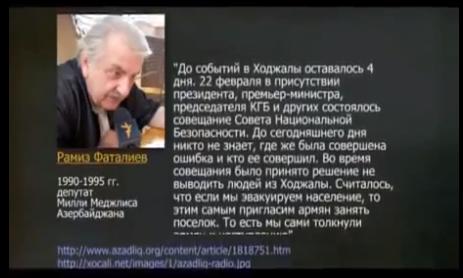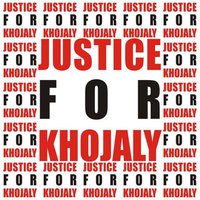|
|
|
|
Falsifications on Khojaly issue. Frame-ups in propaganda films.  Trying
to justify themselves in the eyes of the international community and at
the same to lay the blame for the massacre in Khojaly on the victims
themselves, the Armenian authorities make various propaganda films
every now and then. One of those films is a “documentary” pretentiously
titled “Between famine and fire. The power at the cost of living.” shot
in 2012. Another product of the Armenian propaganda is dedicated to the
Armenian version of the Khojaly massacre (Those interested can watch it
on Youtube)
Trying
to justify themselves in the eyes of the international community and at
the same to lay the blame for the massacre in Khojaly on the victims
themselves, the Armenian authorities make various propaganda films
every now and then. One of those films is a “documentary” pretentiously
titled “Between famine and fire. The power at the cost of living.” shot
in 2012. Another product of the Armenian propaganda is dedicated to the
Armenian version of the Khojaly massacre (Those interested can watch it
on Youtube)Taking into consideration shameful failures in the past, the Armenian government has decided to secure this time and invited not an “amateur- patriot” but a professional PR manager to shoot the film. This time they chose the Vice-President of the Armenian Association for Public Affairs Armand Saghatelyan. Apart from the fact that Mr. Saghatelyan is professional and competent in PR consulting (under Armenian standards), he is also known for his racist attacks against Azerbaijanis, for example, he once said at a news conference in Yerevan that “he knew the basic recipe of training of Azerbaijanis.” Of course, his racist views have played a quite important role in choosing the main producer for this film. In general, there is nothing new in the film, as the handwriting of the Armenian side was all the same- it is manipulation of facts, pulling phrases out of context, digging information from unreliable sources and, of course, an outright lie. The filmmakers never mentioned the report of the Human Rights Watch in the “documentary” and limited to a couple of phrases pulled out from the report of the “Memorial” human rights group. But as a source, they cited redundantly “anti-Azerbaijani revelations” of the former Soviet servicemen, which he had written in his blog in Live Journal and a large part of the film was given to commentary and “memories” of Levon Melik Shahnazaryan widely known for his racist and Azerbaijanophobia statements and appeals. For the creators, and most importantly the contractors of the film, a post in the blog of the former soldier is more important than the report of the “Memorial” and Human Rights Watch, and the opinion of the banal racist Shahnazaryan is much more authoritative, for example, than the views of Human Rights Watch director Holly Cartner. In general, it seems that the film was made for the North Korean audience, which does not have any alternative sources of information. The Armenian authorities cannot understand the main matter: there is so much compelling evidence of their guilt that even if the best Hollywood producers filmed a promotional films for them, it would still be a nasty propaganda, leave alone the “interest for the research community” the Armenian media so much wrote about. In the film, you can find traditional speculation about the “escape route” and “guilt of the Azerbaijani authorities”. Here are a couple of “small discrepancies” in this “documentary”. In the 7th minute the film, there are given words supposedly said by former Secretary of State of Azerbaijan Lala Shovkat Hajiyeva on firing of Khankendi (Stepanakert). The film claims that she spoke them at the beginning of August, 1993, but the Armenian propaganda website www.xocali.net being the primary source of the film alleges that Lala Shovkat supposedly spoke these words in 1992. We would like to remind that in 1992 Lala Shovkat was not the Secretary of state of Azerbaijan and was not in Azerbaijan at all. “Minor inconsistencies” and statements contradicting each other can be traced throughout the “documentary”, which shows either ignorance of the topic by filmmakers, or the deliberate distortion of facts. Then, the film shows “criminals” that were released from the Azerbaijani prisons and “gangs” acting from the Azerbaijani side. The filmmakers obviously got so much carried away by the “creative process” that they forgot that Armenian officials in conversation with representatives of the Memorial, as well as Serge Sargsyan in an interview with foreign journalists claimed that among Armenian forces attacking Khojaly there were people with criminal records.” Speaking of the capture of Khojaly, the Armenian commander Arkadiy Ter-Tadevosyan says that the there were supposedly 600 attackers of the almost defenseless city. However, the brother of the famous Armenian terrorist and one of the commanders of the Armenian forces in Nagorno-Karabakh Markar Melkonyan Monte Melkoniyn, in his book “My Brother's Road: An American's Fateful Journey to Armenia” writes about some 2000 attackers of Khojaly. Thus, the number of invaders was 10 times greater than the number of defenders of the city. Authors of the film quoted a few sentences from an interview [see the link >>>] with Ramiz Fataliyev (chairman of the Parliamentary Commission of inquiry into the Khojaly massacre), but they manage to forge even these few sentences pulled out of context. The original of this interview is in the Azerbaijani language; in the film, his words were submitted in Russian, but with an amendment in favor of Armenians. In particular, Fataliyev says: “A meeting of the Security Council with the participation of the president, the prime minister, the chairman of the KGB, and others was held on February 22, four days before the Khojaly events. Until now, no one have ever figured out where the mistake was made, which led to the Khojaly events. At that meeting, they came to a conclusion that Armenians will take the withdrawal of people from Khojaly as a ground to enter the city. That is, we ourselves would provoke them to break into Khojaly. Even the members of the Security Council did not believe that the Armenians would take such a step that turned into a genocide afterwards. They assumed that if people would flee the city, we ourselves would surrender Khojaly”. The original interview: «Xocalı hadisəsinə 4 gün qalmış – fevralın 22-də prezident, baş nazir, «KQB»-nin sədri və digərlərinin iştirakı ilə Təhlükəsizlik Şurası adlanan qurumun iclası oldu. İndiyə qədər heç kim anlamayıb ki, Xocalı hadisəsinə səbəb olan əsas səhv harada buraxılıb. Həmin iclasda qərara gəldilər ki, əgər Xocalıdan camaat çıxarılsa, ermənilər bunu oraya girmək üçün əsas kimi qəbul edəcəklər. Yəni biz özümüz onları Xocalıya girməyə təhrik etmiş olacağıq. Hətta Təhlükəsizlik Şurasının üzvləri də inanmırdılar ki, ermənilər sonradan genosidə çevrilən belə bir işə gedərlər. Onlar düşünürdülər ki, xalq ordan getsə Xocalını özümüz təslim etmiş olacağıq». In the film, the authors added the following to Fataliyev’s words: “That is, we provoked Armenians to attack”- this small postscript to the words of Fataliyev radically changes the meaning of his statement. Here is the text of the film: “Ramiz Fataliyev: There were left 4 days before the events in Khojaly. On February 22, a meeting of the Council of National Security was held with participation of the president, the prime minister, the chairman of the KGB, and others. Until now, no one have ever figured out where the mistake was made and who was to blame for it. It was decided at the meeting not to withdraw people from Khojaly. They believed that if we would evacuate the population, we would thereby invite Armenians to take over the settlement. That is, we ourselves provoked Armenians to attack”. Obviously, the authors of the film wanted this little postscript to the words of Fataliyev to remain unnoticed, and serve as “proof” that it was the Azerbaijani side to have provoked Armenians to attack Khojaly. The “theses” provided which the authors try to feed people with are of particular interest. Throughout the film there are outlined three main these: 1. Armenians were in a blockade, and therefore were forced to seize Khojaly to break it; 2. It was the Azerbaijani authorities to blame for the death of people, since they did not withdraw them out of the city; 3. In general, it was the total chaos that prevailed at that time in Azerbaijan to blame. Now, everything in order: 1. If Armenians were under siege, how did they manage to obtain weapons and ammunition? Besides, if they had been in the blockade indeed, it would be much more reasonable to break through this very blockade in the direction of Armenia instead of going deeper to the east of Azerbaijan. 2. Concerning the withdrawal of people from the city: why on the earth should people leave their homes? For the only reason that Armenia wished to annex one of the regions of Azerbaijan and did not want to see the Azerbaijani population in this territory? The Armenian side has deplored that it was unable to arrange the ethnic cleansing with hands of the Azerbaijani authorities. 3. As for the confusion that predominated in Azerbaijan, yes, there was a confrontation of the Popular Front with the existing authorities. However, the Armenian side exaggerates the extent of this mess several times. But even if we assume that Azerbaijan was in mess, or even chaos, it cannot justify the killing of civilians on any account at all. It is also surprising that not a word was said about the 366th motorized infantry regiment, deployed in Khankendi (Stepanakert), which participated in the seizure of the city. You can read about it HERE. This fact is another proof that this film is just another mean product of the Armenian government propaganda, and cannot claim to be a documentary, leave alone its inefficacy for researchers. But it probably will be useful for those professionals who analyze methods and techniques of tabloid propaganda. |
| Copyright © 2012 All rights reserved | |


